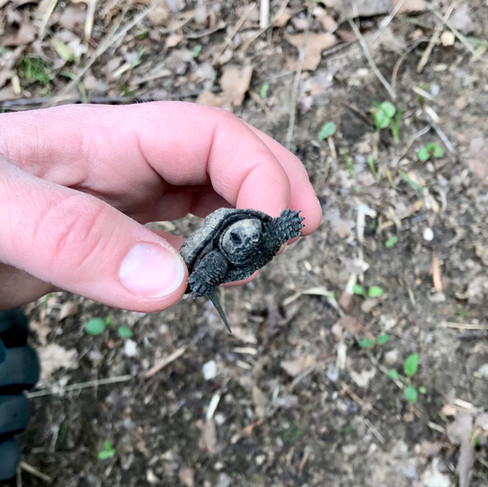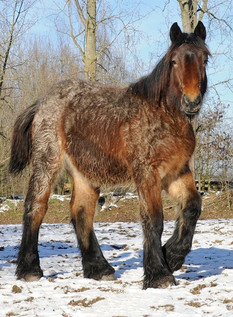1st Quarter 2022
- stacylpearsall

- Jan 1, 2022
- 10 min read
Updated: Mar 22, 2022

The A, B, C’s of Breeding Your Mare
by Rebecca Courtney
For mare owners, making the choice to breed their mare is a big and exciting decision. There’s nothing more fun than enjoying a lively, playful foal, but getting to that point can take a lot of planning and work. If you want to breed your mare in the future, here are a few things to know about the process.
Before jumping into the breeding process, it’s essential to do your research. There are many factors that play into a successful breeding. Make sure to spend time considering the following:

Mare History: How old is your mare? Mares can be bred into their early 20's with no problem, but it’s important to understand that older mares who have not foaled recently can be a challenge to breed at times. On the flip side, if you have a young mare, you need to ensure that she’s sufficiently developed to carry a foal. The preferred age at first breeding depends on who you ask, but generally it is recommended to wait until the filly is at least 3 years old, to foal as a 4 year old. If your mare has foaled in the past, consider whether she had any issues conceiving, delivering or raising her foal. These may might be red flags for a future pregnancy.
Consider Your Resources: Breeding and foaling a mare is a big commitment, especially if you decide to breed using Artificial Insemination. You will need a vet that is comfortable with ultrasounding the mare and understanding the breeding cycle. Talk with your local vet about their experience. If they, or you, do not feel confident in managing the breeding, you may want to inquire about offsite breeding facilities for your mare, or hauling her to a reproductive specialist.
AI vs Live Cover: Determining whether to use Artificial Insemination or Live Cover to breed your mare often comes down to the resources you have available. Live Cover is often cheaper and requires less involvement from the vet, but if you don’t have a stallion nearby, you will have to make arrangements to get the mare hauled to him. Artificial Insemination opens the door to a wider stallion lineup. However, it requires excellent care from a vet, or reproductive specialist, to time the breeding correctly. It can become expensive when you consider mare prep, collection/shipping and vet fees in addition to the stud fee.
Stallion Selection: Knowing the strengths and weaknesses of your mare helps to select a stallion that will complement her. In addition to conformation, consider items such as the ancestry of sire and mare, to minimize inbreeding, any health testing that has been done, and whether the stallion has a Leg Health Report on file with the European Brabant Registry of America.
Test A Mating

The European Brabant Registry of America's comprehensive herd management software, Grassroots, allows Members to test their mares' pairings with stallions for any common ancestors. This helps avoid undesirable breedings and narrows the field of stallions.
Below you'll see a European Brabant Stock studbook mare, Leah, paired with a European Brabant studbook stallion, Victor. Grassroots' calculation indicates no immediate common ancestors on the pedigree chart, so Victor would be a good "genetic" match for Leah.

To demonstrate an example of a bad pairing, below you will see what the calculated outcome would be if Leah were bred to her sire, Scout. NOTE ALL THAT RED!

Mare Prep
Once you have made the decision to breed and have selected a stallion, it’s time to begin working through the breeding process.
In advance of actually breeding the mare, it’s important to establish that her uterus is healthy and clean to nurture an embryo. This is done through a uterine culture and cytology. The

vet will swab the uterus and send a sample off to the lab for analysis. The lab work should show any microorganisms that are present as well as what antibiotics they are susceptible to. If an infection is present, the vet will need to treat it, most often through antibiotic infusions or uterine lavages. After treatment, it is recommended to perform a second culture and cytology to confirm that the infection has cleared up. At the time of culturing, your vet may also perform an ultrasound to determine where the mare is in her cycle and come up with a plan to track her progress to ovulation.
Ovulation and Breeding

When it comes time to actually breed the mare, timing is everything! Mares are in heat for several days, though the exact number can vary based on the mare and time of year. They will ovulate a day or two before going out of heat. This means that it’s pretty much impossible to accurately predict ovulation based on when the mare comes into estrus! If using Live Cover, standard practice is to tease the mare daily with the stallion until she shows willingness to stand for breeding. From there, the mare is covered on an every-other-day basis until she goes out of heat.
Artificial Insemination

If breeding using Artificial Insemination, frequent ultrasounds are used to determine when the mare should be bred. Typically, the mare will be scanned daily, or perhaps every other day early in the cycle, to watch for changes to the uterus and ovaries that indicate impending ovulation. It is comm
on to use an injection to induce ovulation in order to improve the odds of the mare dropping her egg when semen is available. The mare’s cycle progression must be balanced against the stallion’s collection schedule and leave room for shipping times. This is where it is essential to use a vet who is experienced in scanning and managing mares for the best chance of success. Poor management can result in an open mare, and having to start all over again with ultrasounds, collection and shipping fees on the next cycle.
After She's Bred
Once the mare has been bred, a followup ultrasound is often performed the day after breeding (or after final cover, in a Live Cover scenario) to confirm that the mare has in fact ovulated. This also serves as a way to see if the mare is showing any inflammation or fluid accumulation from breeding that would require treatment or a uterine lavage.
From there, it’s a waiting game until the pregnancy is confirmed! An early pregnancy check can be done at 14 days, and it is strongly recommended that a check be done prior to 30 days to ensure that there is only one embryo present, as it is highly unlikely that a twin pregnancy will carry to term. If done beyond 21 days, this check can also be used to confirm that the embryo has a heartbeat. Additional ultrasounds can be done at different stages through the pregnancy to confirm that the mare is still bred, determine the sex of the embryo, and monitor for any potential problems during gestation.
Fun Fact: The Province of Brabant, which stretches over part of modern-day Belgium and the Netherlands, is the birthplace of the European Brabant however, the breed spread throughout many parts of Europe.
Reading a Stallion Contract
by Rebecca Courtney

When stallion shopping, it’s a good idea to get a copy of the stallion’s Breeding Contract to understand the responsibilities of both stallion and mare owner and what to expect through the process. Here are some common features of a Stallion Contract and what to know about them.
Stallion Availability: The contract should spell out when the stallion is available for breeding and also what options are available for live cover or artificial insemination
Stud Fee: This is the fee due to the stallion owner as payment for breeding the mare
Additional Fees: These fees vary widely depending on the stallion and breeding facility. Read through this section carefully to get the full picture of the cost of breeding, and pay attention to which fees are refundable or non-refundable in the case of a failed breeding attempt.
Fees could include:
Booking Fee: A payment due at the time of contract signing to reserve your place in the stallion’s breeding book. This may be credited towards the final stud fee or may be an additional cost.
In a live cover scenario, you can expect to see mare care charges to cover feed and management of the mare during her stay at the farm. There may also be a chute fee that covers the cost of getting help to handle mare and stallion during breeding.
Artificial Insemination contracts come with additional charges for collecting the stallion and shipping the semen. You may also be required to put down a security deposit for the shipping container that is returned when the container is sent back clean and in a timely manner.
Mare requirements: Most stallion owners require that mares have a reproductive examination and a clean uterine culture prior to breeding, to maximize the chance of a successful breeding. If the mare becomes pregnant, the contract may spell out requirements for followup ultrasounds or vaccinations throughout pregnancy
Ordering Semen: Stallion collection often runs on a tight schedule and stallions may not be collected every day. It’s important to understand what days the stallion is available for collection and what the protocol is for ordering a shipment- do you have to call the day before, the morning of, or give a certain amount of notice?
Live Foal Guarantee: This is a common, but not universal, feature of a breeding contract and serves as a degree of insurance that a mare owner will get a foal for their troubles. Be sure to read about what is defined as a ‘live foal’ and the requirements for documenting the loss and notifying the stallion owner in the case of a dead foal. Also, note whether the guarantee gives re-breeding privileges (which may come with a time limit) or is fulfilled through a cash refund (and this generally will NOT include shipping and collection fees, as they are collected on behalf of third parties rather than the stallion owner)
Growing Pains
by Dr. Hernando Plata

When our first European Brabant foal was born from our 27-year-old mare, Salsa, I quickly realized foaling with these gentle giants was going to be a little bit different from the standard-size horses I treat as a board certified Reproductive Equine Veterinarian. Fortunately, I had good friend’s whom I could rely on to learn from their experiences. Cathy Williams told me that these large babies are slow to nurse. She was right; it took more than half a day for our filly, Havanera, to nurse.
When the foal would not nurse in the first 3 hours post-foaling, I was ready to act straight away. I have to confess that I could not resist the temptation, and I treated her as I would if she were one of my client’s horses. Eventually she nursed. I don’t know if she would have done it on her own, or if she did because of my treatments. However, it was music to my ears. Experiences like this one have made me more understanding of what my clients go through.

Once I was at ease by the sound of her suckling, I placed my attention on Havanera's legs. She had severe angular limb deformities, where her front legs looked like a question mark. Fortunately, it did not involve Varus (toeing-in) of the fetlocks. I knew I needed to be patient and give her time. I was not aggressive at all; I did some corrective hoof rasping and trimming. Honestly, I was skeptical any of it would be effective. Patience proved to be hard. After seeing her legs every day for three months, seemingly unchanged, I decided to enlist a second opinion from a veterinary surgeon. Dr Johnson told me what I would usually tell my own clients, "Leave her alone and continue with corrective trimming. She will get straight by herself."
So I did. Her front legs are straight!
Member Profile
by Stacy Pearsall

Every horse person knows the moment they became a "horse person". For Missouri native Olga Pushkareva, it was when her grade school biology teacher organized an extracurricular equine club. Olga and her sister participated frequently and learned to care for and ride horses.
"When I was 17, my family and I immigrated to St. Louis from Russia," recalls Olga. "Money was tight, and we couldn't afford a horse."
Despite not owning a horse, Olga's passion and love for the creatures continued to grow over time. Still, the dream of having one of her own would have to wait. Olga balanced work, education and family, earning Aerospace Engineering degree and an MBA, managing projects for a defense contractor, and guiding her daughter, Jasmine, through adolescence.
After many years of hard work and committed motherhood, the time had finally come. Olga's daughter graduated high school and enlisted in the Navy in 2016, opening a window for Olga's dream of horse ownership. She looked around, studied, contemplated and decided she wanted a draft horse; something calm, loving and gentle. That's when she found Sealy, a bay roan tobiano draft-cross. He was just two when she brought him home. Olga's plan was to ride him, but Sealy had other plans. He preferred to drive.
"A friend of mine was part of the Gateway Harness Club," explains Olga, "And she persuaded me to hitch him when he turned three. He loved it and we have been active with the club ever since. Despite a year of dressage lessons, he still has an unwavering preference for harness work and driving."
Like all other horse people, Olga wasn't content having just one horse. She purchased land with a house and room to grow, and grow they did. Olga's herd expanded when she opened her pasture to a team of underfed American Belgians, Jake and Jason, looking for a soft place to land. They fell into the right hands. Olga immediately got them treated and packing on weight. Sadly, Jason died from colic in 2020, but the upside was Jake would not be friendless for long.
Olga had her sights set on getting a European Brabant and promptly added her name to the waitlist at All the King's Horses in 2018. Two years went by before Olga found her dream horse, Turtle.
Coincidentally, Olga had found a baby snapping turtle near the creek on her farm the month Turtle was born and kept it in a terrarium for a few days. When All the King's Horses' foal profiles were sent, she stopped short on a cute bay roan colt named Turtle.
"I knew it was meant to be," she exclaimed. "I made the trip to Pennsylvania to meet him when he was just one month old. While there, I got to meet his mom, Rosie, and his sire, Ash. It was great to see his sire so relaxed and well behaved. It reinforced my intention of keeping Turtle a stallion and breeding in the future."
Olga, the reluctant teamster, spent time starting Turtle in harness. Since joining her herd, Turtle has mastered Parelli Natural Hosemanship games and learned a great deal from his draft horse pal, Jake. He even made waves at a driving clinic.
"The instructor had a lot of questions," she joked. “We have encountered quite a few people who have never seen a Brabant before. It was a great opportunity to educate others about the breed. Turtle’s calm demeanor and surprising skills for such a young age amazed everyone.”
Turtle has a promising future as a breeding stallion, best friend, riding partner, and pleasure driving horse. The European Brabant Registry of America looks forward to watching him mature into the gentle giant Olga always dreamed of.




































Comments